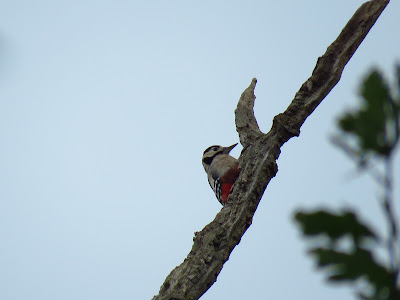
After the WEBS survey at Pickering Park I headed to Brickyard Lane to check Redcliff again. I park near the end of the lane and walk towards the Humber on this wooded lane. What a different day to last week's: cool, cloudy, and still, with an hour to high tide as I arrived. I explored around Brick Lane first. A skein of Pink-footed geese flew over NE, a surprise as so early, but only on Saturday I thought I heard their calls overhead as I left the house.
As I return to the lane, I flush a Grey Wagtail by the large puddle.
There is a mixed flock of tits, with Blue, Great, Long-tailed and a surprise Marsh tit, which repeatedly returns to an elder. A Treecreeper is also about.
Marsh tit.
Marsh tit.
The hot weather of last week has brought the Ivy into blossom. There was a large one growing at the base of a dead tree. Despite the cool conditions, Ivy was bursting with insects, mainly wasps, honey bees and droneflies.
Dronefly, Eristalis tenax.
I scan the flowers looking for Ivy bees and I finally see one! Very active, looks like a female. I manage some record shots. Not my first Yorkshire one, but the first one that is in the right habitat. A colony was found in South Cave a couple of years ago
Female Ivy bee.
The habitat.
I wasn't sure if the beach would be passable at high tide, but there is a lot exposed and it was already high tide, so I decide to give it a try.
In the middle section of Redcliff I spot a Sea Aster bee female on a Sea Aster. It is the only one I see today. I wonder if there are many places where both Ivy and Sea aster bees live in the same area.
As I walk by the recently flooded saltmarsh, I notice thousands of tiny snails on the mud, they are Dun Sentinels,
Assiminea grayana, a tiny snail that lives only in this saltmarsh habitat in estuaries.
Habitat shot of the Dun Sentinel (Click to enlarge).
I get to Long Plantation and check the colony of bees that puzzled me last week. Although near an area of sea aster, they looked more orange than Sea Aster bees, especially the abdominal bands, and given the woodland habitat adjacent to the cliff, I wondered if they would be Ivy bees. The bees are present and quite active, they are hard to count, but I can count 14 at the same time as they buzz about, investigating the nest holes and each other. The ones I take photos of are all males, and this matches the behaviour and the fact none are carrying pollen. They are interested in each other, but after contact, they leave, as if checking if there are females. This time, I manage better photos than last week.







I climb the metal steps and look for ivy nearby. There is plenty on the ground, and immature ivy climbing trees, but the tree just above the nesting aggregation has had its mature ivy cut down. There are a few some mature ivy branches, the ones that produce flowers, but no large specimen like the one at Brickyard lane. I return by the beach, now much more exposed by the tide. The only thing of note on my return is the calling woodpecker at Brickyard lane.












































